
AIEL Shop Tips
WORK STATIONS
|
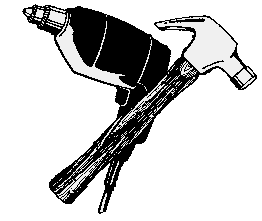
|
Division of your shop space into individual
task areas serves to keep separate each
type of work. Doing this means that the
specific layout, tools and supplies can
be tailored to that task and its workers.
|
Topics
THE FOLLOWING MAY NOT BE REPRODUCED
WITHOUT PERMISSION FROM THE AUTHOR ©
Preliminary
|
A sectioned shop means having individual areas for specific purposes.
This is especially desirable when more than one person will be working
because keeping jobs separate prevents one worker from interfering with
another. There is also the isolation factor where some types of work must
be kept away from others. An example that comes to mind is that electronics
must be kept away from buffer work and from spray painting. In addition,
the latter needs to be specifically ventilated.
Within a given section, further assignments can be made by having
certain tasks devoted to their own stations. Each station should have an
optimal layout for its task(s), and be outfitted with all tools and
accessories required to best do that task -- even if this means duplication
of some items. The purpose of having some things be the same is so that
workers will not have to go elsewhere to find a tool, a rag, a part or
other item that should have already been there.
Realise that topics related to Stations such as Benches, Power, and
Lighting will not be covered here because they are discussed in their own
links accessible from the Work Area Setup Table of
Contents.
Now read further to see specifics regarding the stations suggested in
this article.
|
Buffer Station

If you do refurbishment work, an electric buffer is a must. Outfitted
with a wire-brush wheel and/or a soft polish wheel, items taken here can be
stripped of rust, tarnish, or old paint, and then polished to a restored
finish.
Requirements: Set up an enclosed area because of the dust
and debris raised during the buffing process. Ventilation might be needed,
but at the minimum, have eye and hearing protection, and possibly a face
shield. A selection of pliers will be needed to firmly hold small parts and
to keep skin away from the buffer wheels.
Extras: At this station, store spare wheels and possibly a
hand drill with a wire-brush attachment and extension cord. The latter is
for working on items too heavy or too large to be brought up to the level
of the main buffer.
Fine-Work Station

For close-up work that requires precision, an area for these tasks
should be provided that is clean, well illuminated, and is separated
from any particulate-making operations such as buffing and painting.
A sit-down bench or desk works best for this type of labour.
Tools and Accessories: Have a selection of small drivers,
pliers, dental picks, brushes, cotton swabs, and so on. Provide cleaners and
polishes, and rags in separate trays to prevent cross contamination. An
illuminated magnifier may be considered, as well.
First Aid Station
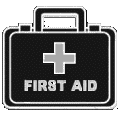
Cuts, abrasions, burns and worse can happen in any shop. Be prepared with
bandages, ointments, disinfectant and more. If you use solvents, an eye wash
kit is recommended. Consider adding antacids, pain medication, and other
over-the-counter medications.
Help: Include a treatment book, and post the telephone
number of the nearest medical facility, along with the address of, and
directions to, that facility.
Glue/Heat Station

Often items will need to be glued. Supplies should include a variety of
adhesives, mixing trays with sticks such as tongue depressors, and ways to
clamp the items being worked upon. Useful tools for this are a pair of
haemostats or a small vice.
Hot Glue: In addition, a hot-melt glue gun with glue sticks
might be considered for this station. Set it up with an illuminated, switched
outlet and heat-proof holster to hold the gun off to one side when not needed.
The gun nozzle should protrude so melted glue won't build up in the holster.
A tray underneath with a teflon pad will catch drips and allow solidified
glue to be later removed.
Concentrated Heat: If you use a heat gun to warm items,
remove labels, or for electronics heat-shrink tubing, have an area for this.
Since heat can be used to cure some glues, this article suggests the glue
and heat stations be one in the same, or at least next to one another.
Get a gun that can stand vertically on its own so that you can rest it
on the bench or desk and manipulate over top of the nozzle the items being
heated. Provide off to one side a heat-proof holster for the gun. The
nozzle should protrude so it can cool without heating the holster.
Office Station
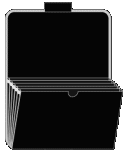
Paperwork will need to be done at some point, and this is the place for
that. It is also suggested that a telephone and computer be installed here,
the latter possibly with an Internet connection. Isolate this area from
dirty work so as to keep it clean.
This is also where shop and equipment manuals, along with repair schedules
should be kept. Have a small file cabinet and keep it organised. Supplies
would include extra file folders, file tabs, and markers.
(See file organisation tips in our
Decluttering your Shop Space
article.)
Accessories:
- Pens
- Notepads
- Sticky Notes
- Ruler
- Rubber Bands
- Paperclips
- File Folders
- Stapler
- Wall Calendar
- Bulletin Board
Additional accessories might include a clock, a name &
phone number directory, or database, and some flashdrives.
Personnel Station

How about a rest area for breaks or lunch as a location to get away
from the shop for a bit? Try to isolate it with a partition or place it
in a small room. An alternative would be to have it in a quiet upstairs
location, if one is available. Furnish it with a table and a few chairs.
Install drawers and cupboards, a microwave oven, and a fridge and sink
if possible. Provide enough outlets on enough circuits to handle the
appliances' current draw, with GFCI outlets for electrical safety near
that sink. A bulletin board would be a good idea for employees, but even
if it's only yourself, posted reminders are a positive thing.
Stock:
- Plates
- Mugs
- Bowls
- Cutlery
- Can Opener
- Drain Board and Tray
- Dish and Hand Towels
- Compost and Recycling Containers
- Garbage Container
Supplies:
- Paper Towels
- Dish Scrubbers
- Dish Detergent
- Liguid Cleaner
- Rags
- Kitchen Wrap or Waxed Paper
Solvents Station
Depending on the type of work you do, you might need solvents. At a
minimum you'll need methanol or rubbing alcohol to clean lamp bulbs.
However, if you deal with paint, oil, adhesives, and/or restoration of
equipment having various kinds of grime, others will be needed.
Consider having:
- Acetone
- Hydrogen Peroxide
- Lacquer Thinner
- Methyl Alcohol(Methanol)
- Methyl Ethyl Ketone
- Mineral Spirits
- Naptha
Keep a selection of rags nearby. Use a metal tray with separate
compartments to hold used rags. This is to prevent cross contamination.
Consider an eye-wash kit as well.
For details regarding various solvents,
their uses and cautions, see
Lubricants and Solvents Purchase Guide
Vacuum Station
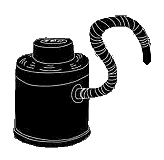
There are always items needing a suction-style of cleaning, even if it's
just the corners of the shop floor. Use an industrial-size model with
good air flow and a large drum that does not need emptying too often.
Set up a vacuum station with all accessories hanging close by. Attachments
should be a crevice tool, floor and upholstery brushes, and possibly a
water squeegee if you has wet-vac capability. Supplies might include extra
bags, and wet and dry filters. Extension hoses would be a plus if you want
to reach far afield from time to time.
Control: Arrange the vacuum power switch to be left on and
controlled instead by a wall switch. Have enough hose so that it can reach
all typically desired benches and areas within reason, and have a bracket
that will take the full coil of hose when in its storage position. Setting
it up this way means that the drum can be placed out of the way under a
bench or counter. Just make sure it's not too hard to access for emptying
and servicing chores.
Wet Station
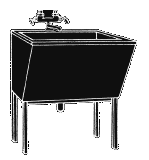
The Sink: This will center around a deep sink such as a
laundry set tub. It should be a fibreglass or similar type that can handle
typical items being washed in a stage lighting shop. Stay away from enamel
or porcelain finishes because they are too slippery, and they will scratch
and chip too easily.
Spray Wash: Install a faucet with a garden hose fitting.
Attach a 1-metre length of hose with a cut-off end which will enable water
pressure to be increased by squeezing. You might consider a commercial
hose with a trigger-style nozzle instead. Arrange the hose to accept both
cold and hot water. Finish off with one or two sink caddies hanging on
the inside of the tub off to one side to hold wet soap pads and sponges.
Illumination: Install a light above the sink that can
handle water being splashed upon its face such as an LED spotlight. Locate
its switch next to it or as close by as possible.
Work Space: Next to the tub should be a counter at the
height of the tub side. Cover it with rubber or sponge matting to make it
waterproof and to be easy on items laid there. You may wish to consider a
dish rack and drain board for smaller items.
Storage: Above and/or beside the sink and counter should
be cupboards for storing supplies. Behind the counter have pegboard for
hanging a selection of brushes and other cleaning utensils.
Supplies:
- Cleaners
- Solvents
- Polishes
- Soap Pads
- Kitchen Eraser Pads
- Scouring Tools
- Tooth Brushes
- Scrub Brushes in a Range of Sizes and Types
- Rags
- Cloth and Paper Towels
Providing stations dedicated to specific tasks
means no interference from/to other departments.
This promotes efficiency and easiness for workers.
This Discussion is
Available in
Plain Text for
Your Archives
Work Stations, Text Format
See More Suggestions in Our
General Tips for the Shop
To see our shop's
work stations, take the
AIEL Photo Tour











